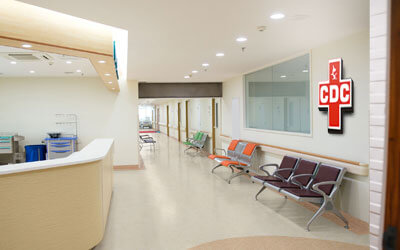01
Tidal volume (VT). This is the amount of air inhaled or exhaled during normal breathing.
02
Minute volume (MV). This is the total amount of air exhaled per minute.
03
Functional residual capacity (FRC). This is the amount of air left in lungs after exhaling normally.
04
Residual volume. This is the amount of air left in the lungs after exhaling as much as you can.
05
Total lung capacity. This is the total volume of the lungs when filled with as much air as possible.
06
Forced vital capacity (FVC). This is the amount of air exhaled forcefully and quickly after inhaling as much as you can.
07
Forced expiratory volume (FEV). This is the amount of air expired during the first, second, and third seconds of the FVC test.
08
Forced expiratory flow (FEF). This is the average rate of flow during the middle half of the FVC test.
09
Peak expiratory flow rate (PEFR). This is the fastest rate that you can force air out of your lungs.
Normal values for PFTs vary from person to person. The amount of air inhaled and exhaled in your test results are compared to the average for someone of the same age, height, sex, and race. Results are also compared to any of your previous test results. If you have abnormal PFT measurements or if your results have changed, you may need other tests.
Why might I need pulmonary function tests?
There are many different reasons why pulmonary function tests (PFTs) may be done. They are sometimes done in healthy people as part of a routine physical. They are also routinely done in certain types of work environments to ensure employee health (such as graphite factories and coal mines). Or you may have PFTs if your healthcare provider needs help to diagnose you with a health problem such as:
02
Respiratory infections
03
Trouble breathing from injury to the chest or a recent surgery
04
Chronic lung conditions, such as asthma, bronchiectasis, emphysema, or chronic bronchitis
05
Asbestosis, a lung disease caused by inhaling asbestos fibers
06
Restrictive airway problems from scoliosis, tumors, or inflammation or scarring of the lungs
07
Sarcoidosis, a disease that causes lumps of inflammatory cells around organs, such as the liver, lungs, and spleen
08
Scleroderma, a disease that causes thickening and hardening of connective tissue
PFTs may be used to check lung function before surgery or other procedures in patients who have lung or heart problems, who are smokers, or who have other health conditions. Another use of PFTs is to assess treatment for asthma, emphysema, and other chronic lung problems. Your healthcare provider may also have other reasons to advise PFTs.
What are the risks of pulmonary function tests?
Because pulmonary function testing is not an invasive procedure, it is safe and quick for most people.
In some cases, a person shouldn’t have PFTs. Reasons for this can include:
01
Recent eye surgery, because of increased pressure inside the eyes during the procedure
02
Recent belly or chest surgery
03
Chest pain, recent heart attack, or an unstable heart condition
04
A bulging blood vessel (aneurysm) in the chest, belly, or brain
05
Active tuberculosis (TB) or respiratory infection, such as a cold or the flu
Your risks may vary depending on your general health and other factors. Ask your healthcare provider which risks apply most to you. Talk with him or her about any concerns you have.
Certain things can make PFTs less accurate. These include:
01
The degree of patient cooperation and effort
02
Use of medicines that open the airways (bronchodilators)
05
Stomach bloating that affects the ability to take deep breaths
06
Extreme tiredness or other conditions that affect a person’s ability to do the tests (such as a head cold)
How do I get ready for pulmonary function tests?
Our healthcare provider will explain the procedure to you. Ask him or her any questions you have. You may be asked to sign a consent form that gives permission to do the procedure. Read the form carefully. Ask questions if anything is not clear.
Tell your healthcare provider if you take any medicines. This includes prescriptions, over-the-counter medicines, vitamins, and herbal supplements.
Make sure to:
01
Stop taking certain medicines before the procedure, if instructed by your healthcare provider
02
Stop smoking before the test, if instructed by your healthcare provider. Ask your provider how many hours before the test you should stop smoking.
03
Not eat a heavy meal before the test, if instructed by your healthcare provider
04
Follow any other instructions your healthcare provider gives you
Your height and weight will be recorded before the test. This is done so that your results can be accurately calculated.
What happens during pulmonary function tests?
You may have your procedure as an outpatient. This means you go home the same day. Or it may be done as part of a longer stay in the hospital. The way the procedure is done may vary. It depends on your condition and your healthcare provider's methods. In most cases, the procedure will follow this process:
01
You’ll be asked to loosen tight clothing, jewelry, or other things that may cause a problem with the procedure.
02
If you wear dentures, you will need to wear them during the procedure.
03
You’ll need to empty your bladder before the procedure.
04
You’ll sit in a chair. A soft clip will be put on your nose. This is so all of your breathing is done through your mouth, not your nose.
05
You’ll be given a sterile mouthpiece that is attached to a spirometer.
06
You’ll form a tight seal over the mouthpiece with your mouth. You’ll be instructed to inhale and exhale in different ways.
07
You will be watched carefully during the procedure for dizziness, trouble breathing, or other problems.
08
You may be given a bronchodilator after certain tests. The tests will then be repeated several minutes later after the bronchodilator has taken effect




